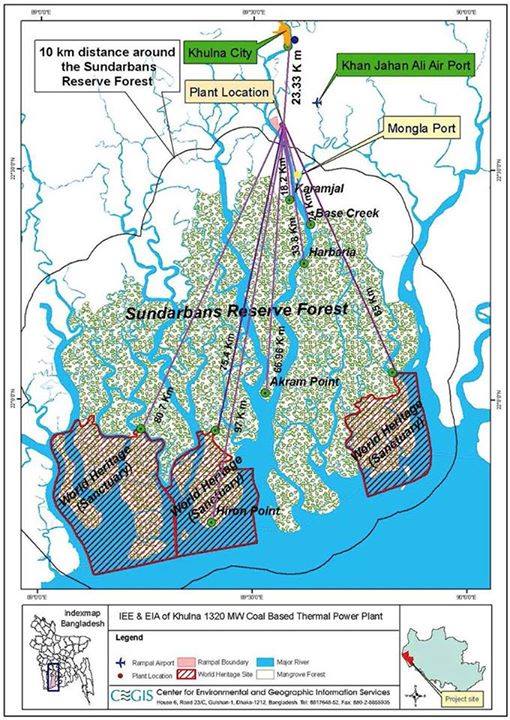
 India has a lot of coal underneath the ground, and so, it started to exploit the resource a bit early and has been doing it abruptly to meet the rising electricity demand of the industries and households.
India has a lot of coal underneath the ground, and so, it started to exploit the resource a bit early and has been doing it abruptly to meet the rising electricity demand of the industries and households.
The consequence is not pleasant, though the power generation capacity has reached rocket-high, because now the next-door neighbour has polluted most parts of the country’s land, water and air where coal-fired power plants are installed.
Moreover, the massive extraction of coal through hazardous but cheap “open-pit mining method” across the country has already left serious impact on the environment and particularly the health of the miners and people of the nearby areas.
It should be noted that the quality of India’s coal is one of the worst in the world!
It is astonishing that the subsequent governments in India, which is a fast-growing super power, have ignored the people and the Nature only for the greater interest (!) of saving money of the government and private investors!!!
Okay, every development initiative is praiseworthy, but at what cost?
The gigantic moves of the state-owned National Thermal Power Company (NTPC) — corrupt and callous — have made the government highly-ambitious. Now they’ve been upbeat about setting up more coal projects in Bangladesh and Sri Lanka!
India’s scientists are ridiculous as they have been staying reluctant over the issue.
So far, none but the conservationists voice concern over the ever-degrading environment in India.
It is, however, praiseworthy that India’s National Green Tribunal acts sometime in favour of the environment, for instance, on March 12, 2014 it suspended the environmental clearance issued for the NTPC to build a power plant in Karnataka state.
The reasons behind the decision are more concerning: 1) to get the clearance, the NTPC gave wrong and unclear information about the land of the project area; it said the arable land was not fertile, 2) the clearance was issued before the NTPC prepared compensation and rehabilitation plans, 3) softened the impact of coal-fired power plants, and 4) the NTPC ignored locals’ opinions.
While constructing the 1320MW coal-based power plant on the bank of Pashur River — a fresh water dolphin sanctuary, and beside the Sundarbans — a Unesco World heritage Site, both the Bangladesh and Indian government violated a number of rules they formulated. They committed serious crimes by giving false information in the Environmental Impact Assessment (EIA) report and the feasibility study. The Department of Environment (DoE) of Bangladesh violated its own condition given for the project upon the government pressure.
Yes, pressure; it comes from both the governments when the Bangladeshi one is eager more to implement the project. Prime Minister Sheikh Hasina inaugurated construction of the project on October 6 last year through a video conference — apparently to avoid ire of the conservationists who few days back carried out a long-march from Dhaka to Rampal in Bagerhat protesting the project.
Before that the Bangladesh Army was given the job of land-filling in the project area to avoid the protesters. Still, the work was underway defying environmental laws.
Much before that, the High Court of Bangladesh showed its shit-face by rejecting and not hearing all the three petitions filed against the power plant project.
While approving the faulty EIA, the DoE said the adverse impact of the plant would be slow, and they’ll monitor the operation. The high-ranking official who deals the project justified the approval saying that there had been many big installations around the mangrove forest for long, including an export processing zone and several cement factories.
It’s also shocking to know from newspaper reports that the local administration has long been allowing sale of land in the area for hazardous shipbreaking yard and other industries.
Latest, an Indian delegation visited the Rampal site on April 2 and has continuously been giving wrong information about the project.
Who cares? Who to blame? How to get away from the hands of the corrupt authorities? How to protect the mother Nature for the future generations?
The last resort was an international arbitration. During my Poland visit in November I spoke to the chief of United Nations Framework Convention on Climate Change (UNFCCC), Christiana Figueres, to know whether there were any means to stop the Rampal project through the UN body or by any other international court dealing with related issues.
“There is no such effort or such authority. Every country is sovereign, and establishes [projects] the way it wishes to pursue its sustainable development,” she said.
“In particular with developing countries, our most challenge right now is how they pursue their sustainable development; which means, in their pursue of energy and supplying growing energy demands, the developing countries must pursue a path of energy which is accessible, reliable and environmentally responsible. And we will expect those three different characteristics that all countries would pursue,” she frustrated me!
